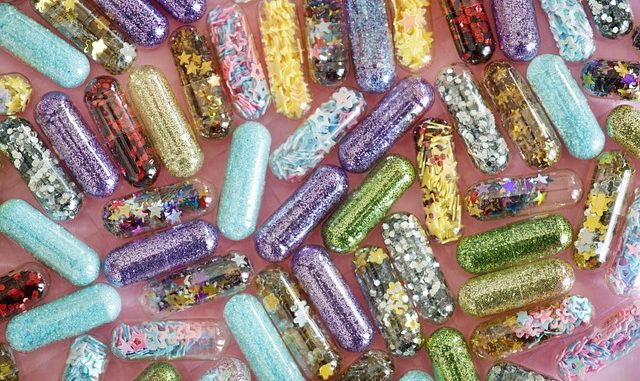
Microencapsulation is a technology for protecting sensitive ingredients with materials which act as barriers. These barriers help keep the ingredient more stable, they may reduce an objectionable flavour, disguise a colour or reduce a smell or aroma.
A number of bioactives have all been encapsulated. Probiotics, astaxanthin, resveratrol are all examples which have been encapsulated in some form of another. It’s also a technology which finds its way into textile development (Nelson, 2002).
The technique of microencapsulation involves coating liquid droplets or solid particles in a thin coating of some protective material. What is formed is a two-phase system.
The materials that are coated are known as the ‘core’ whilst the film forming or coating material is the wall or shell (Dziezak, 1988). The core should be completely isolated from the external environment. The core materials should not be affected if the correct protective barrier is chosen for this purpose.
The encapsulated materials are also called microcapsules, coated granules, pellets and microspheres.
As well as food, the technology is regularly used in the cosmetics, textiles, papers using certain inks and the advanced materials industry. The main reasons for microencapsulation include:-
- Controlled release as with drugs and the possibilities for sustained and prolonged release e.g. vitamins and minerals, enzymes
- Taste masking e.g. castor oil
- Reducing toxicity and gastrointestinal irritation e.g. endomethacin
- Stability during packaging and storage as with vitamins
- Improved flow properties of sticky materials g. vitamin B1 (thiamine)
- Converts liquids into solid materials for ease of handling and storage e.g. fish oils
- Reducing the volatility of materials e.g. aspirin
- Protection of seeds such as oilseed rape (Tay et al., 1993).
The advantages of encapsulation of materials over gel entrapment is that the latter structure has a tendency to breakdown producing untimely leakage from the gel matrix. There are also issues with diffusion – it is limited in gels. Not only is the material encapsulated more firmly held inside but the mass transfer limitations are claimed to be less both in terms of loss of material but also unwanted ingress.
The Release Mechanisms For Microencapsulation
- Erosion – the shell degrades through changes in pH and enzymatic hydrolysis.
- Degradation of a controlled monolithic system – the encapsulated material is released when the matrix breaks down
- Diffusion controlled monolithic system – the encapsulated material diffuses through the shell which eventually breaks down.
- Diffusion controlled reservoir system – the drug from the capsule diffuse out as the shell membrane disappears
The coating material can be many and varied. They include water soluble and insoluble resins, waxes and lipids and what are termed enteric resins.
Water soluble resins include gum Arabic, carboxymethylcellulose, polyacrylic acid.
Water insoluble resins include polyethylene, polymethacrylate, cellulose nitrate.
Waxes and lipids include bees wax, carnauba wax, paraffin, stearyl alcohol
The enteric resins include zein from maize, shellac and cellulose acetate phthalate.
Mixed encapsulant systems exist – chitosan with alginate (Tay et al., 1993), chitosan with carboxymethylcellulose(CMC) (Yoshioka et al., 1990).
The usual methods of manufacture include either physical techniques or chemical ones:-
(1) Physical methods
Spray-drying (one of the most popular)
Air-suspension coating or the Wurster method relies on suspending particles in an upward moving air stream within a coating chamber. The coating material is sprayed onto the air suspended particles. This cyclic process is repeated depending the degree of encapsulation required and what the purpose is for. The air stream dries the core.
Coacervation. Complex coacervation is one of the leading methods for all sorts of encapsulation especially when oils are to be encapsulated.
Pan coating occurs when solid particles are mixed with a dry coating material. The temperature is raised and the coating material melts. This encloses the core particles. Cooling causes the coating to solidify and in the process forms a microcapsule.
(2) Chemical Processes
- Solvent evaporation
- polymerization
Capsule Size
Microencapsulates are characterised by their size which are:- macrocapsules (>5,000μm), microcapsules (0.2 to 5,000μm) and nanocapsules (<0.2μm).
The materials for encapsulation are many and varied They include gums, starches, various polysaccharides.
Issues With Microencapsulation
In some cases there can be a reaction between the core and the shell materials. It’s also difficult to achieve a uniform and an even continuous film around the core. In some cases the shelf-life of hygroscopic drugs or ingredients is actually reduced by the process. There are instances when the polymer used is actually toxic and not safe to ingest for example.
Clearly the process is costly and requires people who know what they are doing.
Analytical Tests
- Particle size and shape: using light microscopy and electron microscopy, the size and shape of the particle is visually examined. It allows for checking of the uniformity of coating.
- Density determination – usually measured with a multi-volume pychnometer.
- Contact Angle – a good measure of the wetting properties of the capsule.
- Isoelectric point- using microelectrophoresis, the electrophoretic mobility is assessed.
- In vitro release methods – a technique which analyses how well the core is released in different chemical conditions such as changes to pH.
References
Benita, S. (Ed.). (2005). Microencapsulation: methods and industrial applications. CRC Press.
Dziezak, J.D. (1988) Microencapsulation and encapsulated ingredients. Food Technol. 42(4) pp. 136-151.
Nelson, G. (2002). Application of microencapsulation in textiles. International Journal of Pharmaceutics, 242(1-2), pp. 55-62 (Article)
Tay, L. F., Khoh, L. K., Loh, C. S., & Khor, E. (1993). Alginate–chitosan coacervation in production of artificial seeds. Biotechnology and Bioengineering, 42(4), pp. 449-454.
Yoshioka, T., Hirano, R., Shioya T. and Kako, M. (1990). Biotechnol. Bioeng. 35, pp. 66–72
Leave a Reply